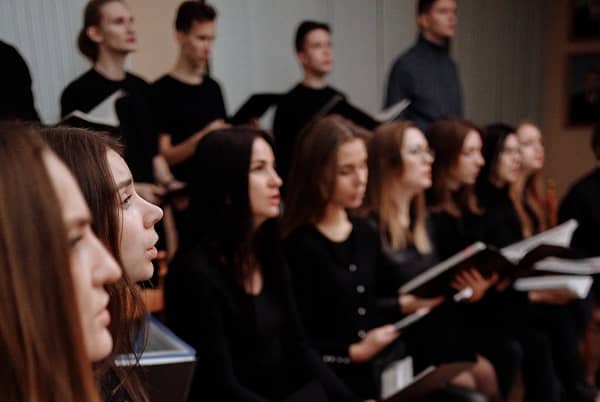Have you ever listened to a choir perform an intricate classical piece or four-part harmony, resulting in goosebumps and a sense of awe at their skill?
As you take in the layered melodies and pure tones, you likely assume it’s raw talent. However, behind most top-tier choir performances lies an essential skill: sight reading excellence.
Why Sight Reading Matters
Similar to learning a new language, reading music is a translation process. We learn to recognize tonal and rhythm patterns like familiar words on a page. Studies show students who receive music reading instruction from a young age have brains that develop to “hear” what they see, like reading a book.
Strong sight reading skills allow your choir to lift off the page confidently, reducing dependence on the piano and opening doors to greater musical expression. When singers imitate rather than read parts, small lags emerge. Interdependence forms the foundation of tuning and unity.
Fact: Choirs who incorporate sight reading daily demonstrate quicker learning, tighter harmonies, and more creative expression.
Developing Essential Sight Reading Skills
Before diving into strategies for your choir, ensure you’re establishing proper sight reading mechanics.
Visual Tracking
Keeping place in the music enables singers to move fluidly from note to note. Have students run their fingers under notes, mouthing letter names. Changing tempo mid-exercise boosts adaptability.
Rhythmic Recognition
Note values, rests, dotted notes, syncopation – all elements singers must instantly recognize to perform rhythms accurately. Isolate rhythm exercises chant/clap before adding pitches.
Pitch Recognition
Matching notation to sound Familiarity with bass and treble clefs, sharps/flats, and pitch tendencies helps choirs hear coming notes. Apps like TETuner boost skills.
Audiation/Inner Hearing
Hearing music when none plays represents high-level sight reading. First, establish tonality, then remove the audio cue. Students should perform parts by “ear.”
Music Theory Basics
Understanding time signatures, solfege, and intervals – sight reading utilizes multiple musical dimensions simultaneously. Ensure the choir has fundamentals.
Assessment of Skills
Gauge abilities through rubrics tracking visual tracking, rhythmic accuracy, audition, and more. Then target problem areas. Milestone celebrations further motivation!
Building a Culture of Sight Reading Excellence

Like an instrument, excellent sight reading requires regular honing. Schedule brief daily exercises, or use them as warmups. Repetition across weeks, months and years develops automaticity excelling choir share.
Fact: 91% of award-winning high school choirs incorporate sight reading at each rehearsal.
Fold sight reading into your group’s habits and identity. Section leaders model and motivate. Directors celebrate small wins that accumulate into excellence. Before long, it becomes natural as breathing.
Actionable Techniques and Strategies
Arm your choir with sight reading superpowers through these practical approaches:
Warm Ups and Posture
Clear minds and relaxed bodies optimize learning. Begin with humming, stretching or simple scales – comfortable territory. Proper alignment enables free sound.
Scan and Analyze Sheet Music
Before singing, silently scan for challenging areas – large leaps, contrasting rhythms. Lightly tap the tempo and make mental notes. Map the journey before embarking!
Slow Down and Listen to Unfamiliar Songs
Apps like AudioStretch provide illumination before committing sound. Slowing 75% lets choirs hear nuances missed at full tempo. Internalize prior to imitating.
Hum/Sing on Vowels to Map Out Phrases
Neutral syllables allow focus on the length of phrases and breath planning. Buzzy lips free the voice. Mark places to sneak quick inhales before adding lyrics.
Mouth Words Without Singing
Enter the lyrics dimension after the melody/rhythm set. Quietly mouth the text while tracking visually. Layer by layer, broaden ability.
Sing Softly, then Begin Performing
Whisper singing builds confidence to then emit modest sound. Crescendo skill through stages until full artistic expression radiates. Use recordings to hear and improve.
Record and Review
Listening back objectively exposes rough edges not apparent amidst strain of performing. Make notes and self-assess, celebration small successes.
Creative Rehearsal Exercises
Infuse novelty combatting monotony. Try:
Reverse Order: Sing measures backwards. Doubling length challenges brains.
Section Battles: Each section sings a measure round-robin style. Last one standing wins!
Audiate Pitches: Sing while silently hearing certain notes. Develops inner musicality.
Randomize Measures: Skip throughout piece. Flexibility and recovery strengthen.
Adding variety accelerates skill acquisition while keeping things lively!
Tracking Progress and Growth
Set milestones, assess using rubrics, and recognize progress made. Measurement motivates. With consistent community and incremental challenges, abilities compound quickly. Before you know it, your choir will be sight-reading pieces that once seemed impossible.
The key is dedication throughout the journey. Maintain perspective along the path. Remain faithful to the process.
Imagine what expression is possible when notation translates directly into sound when singers inhabit lyrics as second nature. That musical freedom unlocks the next level of performance.
Final Words
You now hold ideas and techniques to begin that sight reading journey with your choir.
Start small and build consistency. Infuse creativity when inspiration strikes. Stay committed to growth. And knowing the musical transcendence on the other side makes every bit of practice worthwhile.


